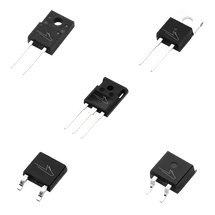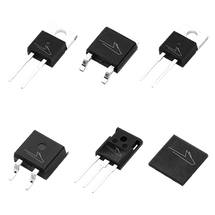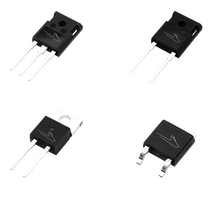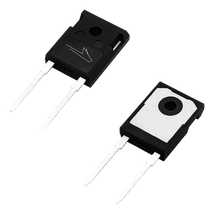Improve thermal management and conserve power with Wolfspeed’s New TSC MOSFETs and Schottky diodes.
Discrete Silicon Carbide Schottky Diodes
Further reduce conduction losses with ultra-low voltage drop Schottky diodes in power rectifier applications, or any circuit that requires protection from reverse current.
Products
No filters selected, showing all 54 products
Filter By
Product SKU | Buy Online | Request Sample | Data Sheet | CAD Model | Status | Blocking Voltage | Current Rating | Forward Voltage(VF(type)) | Maximum Continuous Current (IF) | Package | Qualification |
|---|---|---|---|---|---|---|---|---|---|---|---|
Active | 600 V | 2 A | 1.5 V | 2 A | TO-252-2 | Industrial | |||||
Active | 600 V | 4 A | 1.5 V | 4 A | TO-252-2 | Industrial | |||||
Active | 600 V | 4 A | 1.5 V | 4 A | TO-220-F2 Full | Industrial | |||||
Active | 600 V | 4 A | 1.5 V | 4 A | TO-220-2 | Industrial | |||||
Active | 600 V | 6 A | 1.5 V | 6 A | TO-220-F2 Full | Industrial | |||||
Active | 600 V | 6 A | 1.5 V | 6 A | TO-220-2 | Industrial | |||||
Active | 600 V | 8 A | 1.5 V | 8 A | TO-263-2 | Industrial | |||||
Active | 600 V | 8 A | 1.5 V | 8 A | TO-220-2 | Industrial | |||||
Active | 600 V | 10 A | 1.5 V | 10 A | TO-263-2 | Industrial | |||||
Active | 600 V | 10 A | 1.5 V | 10 A | TO-220-2 | Industrial | |||||
Active | 600 V | 20 A | 1.5 per leg | 20 A | TO-247-3 | Industrial | |||||
Active | 650 V | 4 A | 1.5 V | 4 A | TO-220-2 | Industrial | |||||
Active | 650 V | 4 A | 1.27 V | 4 A | TO-252-2 | Industrial | |||||
Active | 650 V | 4 A | 1.27 V | 4 A | TO-220-2 | Industrial | |||||
Active | 650 V | 6 A | 1.27 V | 6 A | QFN 8x8 | Industrial | |||||
Active | 650 V | 6 A | 1.5 V | 6 A | TO-252-2 | Industrial | |||||
Active | 650 V | 6 A | 1.27 V | 6 A | TO-252-2 | Industrial | |||||
Active | 650 V | 6 A | 1.27 V | 6 A | TO-220-2 | Industrial | |||||
Active | 650 V | 8 A | 1.27 V | 8 A | QFN 8x8 | Industrial | |||||
Active | 650 V | 8 A | 1.5 V | 8 A | TO-220-2 | Industrial | |||||
Active | 650 V | 8 A | 1.27 V | 8 A | TO-252-2 | Industrial | |||||
Active | 650 V | 8 A | 1.27 V | 8 A | TO-220-2 | Industrial | |||||
Active | 650 V | 8 A | 1.5 V | 8 A | TO-220-2 Isolated | Industrial | |||||
Active | 650 V | 10 A | 1.27 V | 10 A | QFN 8x8 | Industrial | |||||
Active | 650 V | 10 A | 1.27 V | 10 A | TO-263-2 | Industrial | |||||
Active | 650 V | 10 A | 1.5 V | 10 A | TO-220-2 | Industrial | |||||
Active | 650 V | 10 A | 1.27 V | 10 A | TO-252-2 | Industrial | |||||
Active | 650 V | 10 A | 1.27 V | 10 A | TO-220-2 | Industrial | |||||
Active | 650 V | 10 A | 1.5 V | 10 A | TO-220-2 Isolated | Industrial | |||||
Active | 650 V | 16 A | 1.27 V | 16 A | TO-247-3 | Industrial | |||||
Active | 650 V | 16 A | 1.5 V | 16 A | TO-220-2 | Industrial | |||||
Active | 650 V | 20 A | 1.27 V | 20 A | TO-263-2 | Industrial | |||||
Active | 650 V | 20 A | 1.27 V | 20 A | TO-247-2 | Industrial | |||||
Active | 650 V | 20 A | 1.27 V | 21 A | TO-220-2 | Industrial | |||||
Active | 650 V | 20 A | 1.27 V | 20 A | TO-247-3 | Industrial | |||||
Active | 650 V | 30 A | 1.35 V | 88 A | TO-247-2 | Industrial | |||||
Active | 650 V | 30 A | 1.5 V | 30 A | TO-247-3 | Industrial | |||||
Active | 650 V | 50 A | 1.3 V | 50 A | TO-247-2 | Industrial | |||||
Active | 650 V | 50 A | 1.3 V | 50 A | TO-247-3 | Industrial | |||||
Active | 1200 V | 2 A | 1.4 V | 2 A | TO-252-2 | Industrial | |||||
Active | 1200 V | 5 A | 1.4 V | 5 A | TO-252-2 | Industrial | |||||
Active | 1200 V | 5 A | 1.4 V | 5 A | TO-220-2 | Industrial | |||||
Active | 1200 V | 10 A | 1.5 V | 10 A | TO-252-2 | Industrial | |||||
Active | 1200 V | 10 A | 1.4 V | 10 A | TO-247-3 | Industrial | |||||
Active | 1200 V | 10 A | 1.5 V | 10 A | TO-220-2 | Industrial | |||||
Active | 1200 V | 20 A | 1.5 V | 20 A | TO-247-2 | Industrial | |||||
Active | 1200 V | 20 A | 1.5 V per leg | 20 A | TO-247-3 | Industrial | |||||
Active | 1200 V | 20 A | 1.5 V | 20 A | TO-220-2 | Industrial | |||||
Active | 1200 V | 30 A | 1.5 V | 30 A | TO-247-2 | Industrial | |||||
Active | 1200 V | 30 A | 1.6 V per leg | 30 A | TO-247-3 | Industrial | |||||
Active | 1200 V | 40 A | 1.5 V | 40 A | TO-247-2 | Industrial | |||||
Active | 1200 V | 40 A | 1.5 V per leg | 40 A | TO-247-3 | Industrial | |||||
Active | 1700 V | 10 A | 1.5 V | 10 A | TO-247-2 | Industrial | |||||
Active | 1700 V | 25 A | 1.5 V | 25 A | TO-247-2 | Industrial |
Explore The Options
Featured Resources
Design Tools
Technical Support
Featured Application Notes
Documents, Tools & Support
- Technical & Sales Documents
- Tools & Support
- Compliance
Documents
16 Documents Available
Document Type | Document Name | Last Updated |
|---|---|---|
| Application Notes | 02/2025 | |
| Application Notes | 07/2024 | |
| Application Notes | 01/2024 | |
| Application Notes | 01/2024 | |
| Application Notes | 01/2024 | |
| Application Notes | 12/2023 | |
| Application Notes | 08/2023 | |
| Application Notes | 01/2023 | |
| Application Notes | 09/2022 | |
| Application Notes | 02/2022 | |
| Application Notes | 09/2015 | |
| White Papers | 11/2025 | |
| White Papers | 11/2025 | |
| Product Catalog | 01/2025 | |
| Sales Terms | 04/2025 | |
| Packing & Shipping | Power Product Packing & Shipping Reference Guide (PDF) This document details the production packaging details including container type, quantity, MOQ, and dimensions as well as the moisture sensitivity level (MSL) for discrete SiC Schottky Diodes and MOSFETs.
| 11/2025 |
Knowledge Center
Silicon carbide is revolutionizing the heat pump and air conditioning industry by delivering unprecedented efficiency, enhanced durability, and superior performance in the most challenging of environments.



